Huawei Mate 20 Pro is one of our best reviewed smartphones year. It is flagship device that we mostly recommend, and everything is deeply rooted from how it performance in various features it presents. From raw gaming to photography performance, Huawei’s latest flagship is a smartphone that’s hard to beat by its competitors.
If there’s one smartphone within its category and price range that can directly compete with Mate 20 Pro, it is clearly the Samsung’s Galaxy Note 9. It is among the best Android devices available in the market, and it presents a wildly different ecosystem that you’re used to, but it’s hard to pass on all its features like the S Pen, Iris Scanner, variable camera aperture setup and long battery life.
At this point, we’re going to pit both devices to a photo shootout. Each device presents a variety of features per camera module (main and selfie), and we will show how both smartphones efficiently utilize everything to produce photos.
For reference, here are the specifications of their respective camera sets.
[table id=228 /]
Aperture Mode/Live Focus
Let’s start off with the first feature that both smartphones excel in: Aperture Mode. This is presented in various ways, and in the case of Huawei Mate 20 Pro, they simply call it Aperture Mode; and for Galaxy Note 9, it’s Live Focus.
It is interesting to note how Huawei separated Aperture Mode to Portrait Mode. If you’re used to this concept, you will get confused with how Samsung implemented it on Galaxy Note 9 (and even Galaxy S9). Whatever be the case, this feature essentially lets you apply and modify depth of field.
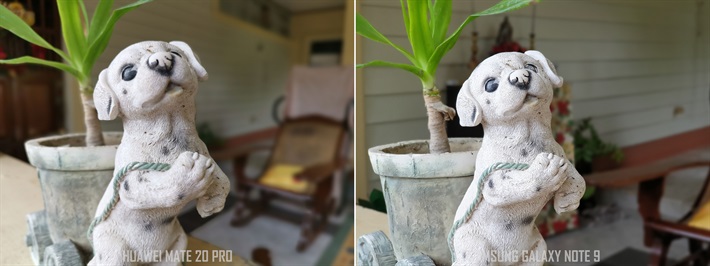

 Mate 20 Pro’s Aperture Mode is better in terms of software implementation. You can switch from 1x to 3x zoom to your heart’s content, and even adjust the aperture level from f/0.95 to f/16. While the phone’s brightest aperture is at f/1.8, it can be interpolated to f/0.95 at whim.
Mate 20 Pro’s Aperture Mode is better in terms of software implementation. You can switch from 1x to 3x zoom to your heart’s content, and even adjust the aperture level from f/0.95 to f/16. While the phone’s brightest aperture is at f/1.8, it can be interpolated to f/0.95 at whim.
In terms of quality, the subject taken by Mate 20 Pro has more color definition, albeit a little too soft and darker by our standards. When compared with Note 9, colors are less saturated but brighter. Despite having a brighter aperture (f/1.5), Note 9 locked it to f/2.4 compared to the other photo (taken by Mate 20 Pro). Note 9 has dual aperture, which lets you switch f/1.5 and f/2.4; unfortunately, you can’t use this feature via Live Focus.

In terms of bokeh, both render impressive depth of field quality. In the case of Mate 20 Pro though, we suggest that you hold off from pushing up the aperture level to f/0.95 to avoid unusual background blur rendering.
HDR
HDR is a technology that most smartphone photographers are used to. Those who love taking landscape photography or subjects in various exposure levels, which then affect the overall quality of the output. From combining several photos in various shooting conditions in an instance to contrast ratio tweaks, it is obvious that there’s a lot of things that are happening in HDR photography.
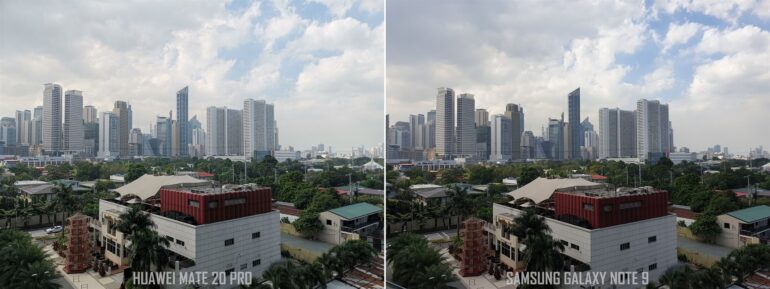
We’re thrilled to report that both devices nailed this category. The structure of clouds looks great and the level of contrast aren’t too blown out on both devices. However, it only takes one tap on the Mate 20 Pro to enable this feature; Galaxy Note 9 requires you to switch HDR (Rich Tone) in the settings menu, which is 3 taps away from Auto Mode. It would have been a lot better had Samsung put a switch or toggle on the viewfinder for easy access.
MANUAL MODE
Professional photographers usually break away from Auto Mode. This is the very reason why phones like Mate 20 Pro and Note 9 appeal to a lot of professionals. Both devices have this feature, and the usual manual photography controls are available in the UI.
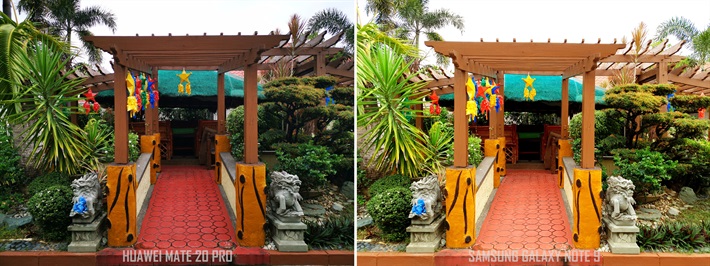
- ISO Level
- Aperture Level
- Colors
- White Balance
- AF/MF
The major advantage of Galaxy Note 9 in this aspect is the ability to toggle the aperture from f/1.5 to f/2.4 by simply tapping one switch, thanks to its dual aperture feature. While both smartphones have manual focus on this mode, there is currently no way to use this taking a video on the Mate 20 Pro. You can play with focus while taking a video on Galaxy Note 9.
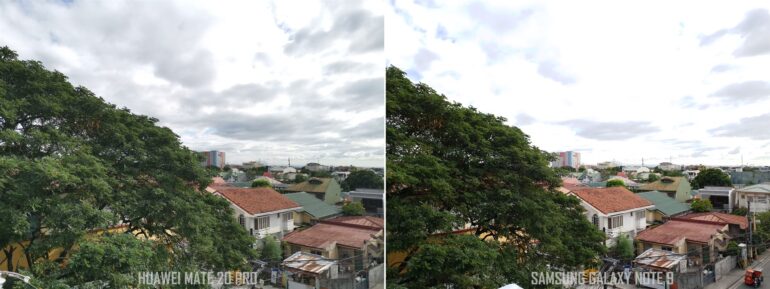 In terms of quality, Huawei Mate 20 Pro performs better in similar conditions and settings. Here’s a photo I took at the same time and similar settings. Photo I took using Mate 20 Pro has better image details.
In terms of quality, Huawei Mate 20 Pro performs better in similar conditions and settings. Here’s a photo I took at the same time and similar settings. Photo I took using Mate 20 Pro has better image details.
You can also take photos in RAW mode; and both phones keep JPG and RAW copies of your shots. I recommend that you enable this feature and use Lightroom or Photoshop Express to adjust if you’re into adjusting your photos at post.
PORTRAIT MODE
Jumping to one of the most used modes on both phones – Portrait Mode. This is in a separate category on the Mate 20 Pro, while it is part Live Focus on Galaxy Note 9. Focal length shifts when Live Focus is enabled on the latter; and it usually requires a well-lighted subject.
The reason people why people are shooting in Portrait Mode is produce photos that focus intently on the subject, somewhat negating the background using background blur or bokeh.

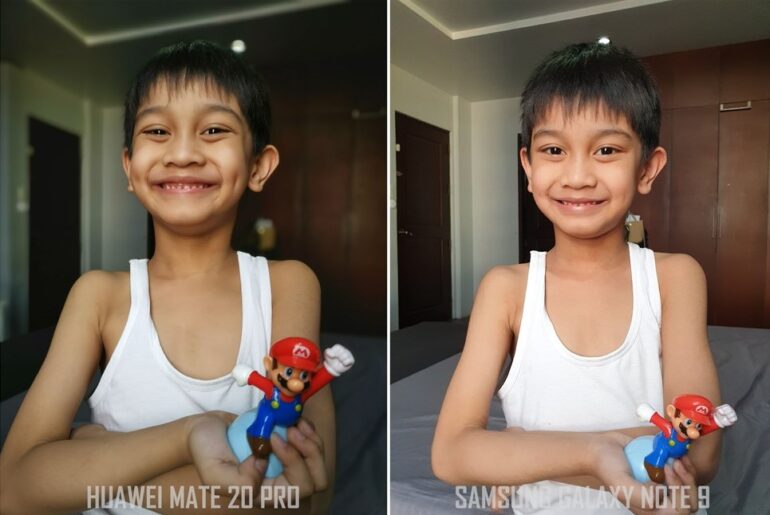
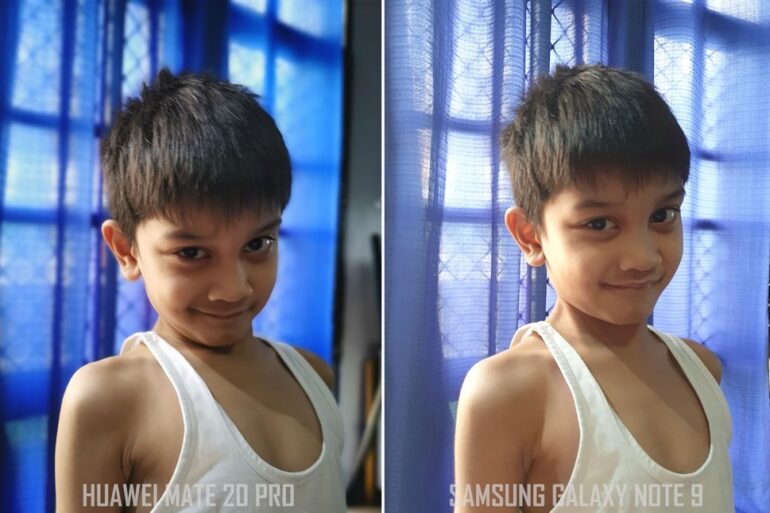 Huawei Mate 20 Pro clearly wins this round. They even added a feature where you can change the shape of any light in the bokeh to various shapes: circles, hearts, swirl and discs. There are also various artificial lighting modes to choose: photo booth, stained glass, folding blinds, pop ang stage lighting. Galaxy Note 9, on the other hand, only has Skin Tone adjustment on this mode.
Huawei Mate 20 Pro clearly wins this round. They even added a feature where you can change the shape of any light in the bokeh to various shapes: circles, hearts, swirl and discs. There are also various artificial lighting modes to choose: photo booth, stained glass, folding blinds, pop ang stage lighting. Galaxy Note 9, on the other hand, only has Skin Tone adjustment on this mode.
DAYLIGHT PHOTOGRAPHY
Daylight photography strikes as one of the most often used modes on a camera smartphone. For one, taking photos during day time doesn’t require users to tweak a lot of camera settings. Users mostly take photos with Auto Mode enabled and having a reliable AI to take care of intelligently set settings is definitely a plus factor.
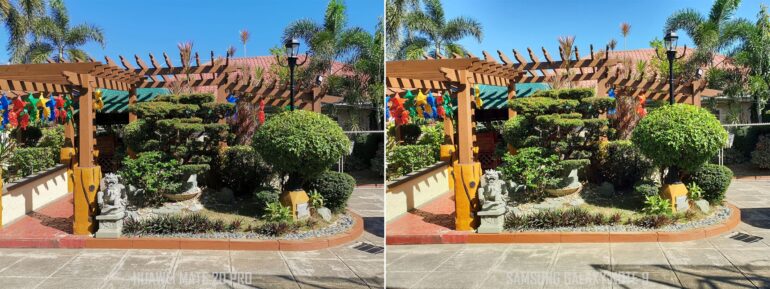 The lowdown: Both phones performed with flying colors in daylight photography. Speaking of colors – the level and mix of saturation and contrast on photos taken by Huawei Mate 20 Pro looked better by our standards. Thanks to its superior AI performance, a technology that Huawei has been harnessing since the time they announced P20 Pro. Huawei also somehow fixed the overblown and overperforming AI when taking daylight photography, which causes photos to be overly saturated.
The lowdown: Both phones performed with flying colors in daylight photography. Speaking of colors – the level and mix of saturation and contrast on photos taken by Huawei Mate 20 Pro looked better by our standards. Thanks to its superior AI performance, a technology that Huawei has been harnessing since the time they announced P20 Pro. Huawei also somehow fixed the overblown and overperforming AI when taking daylight photography, which causes photos to be overly saturated.
Galaxy Note 9, in most respects, performed really good too but the colors produced are less punchier and dramatic. The camera set of Note 9 is powerful, and it only a matter of tweaking the software settings and AI for it produce better looking photos.
INDOOR PHOTOGRAPHY
Indoor photography is usually trickier to pull off as subject requires more light. If you rely heavily on Auto Mode, the tendency is bring up the ISO and slower the shutter speed to produce a relatively decent looking photos. Sometimes, photos would appear too noisy and with less punchier photos. It usually pays to have an intelligent AI on the smartphone to look for the right settings, rendering users to be taking photos at ease and hassle free.
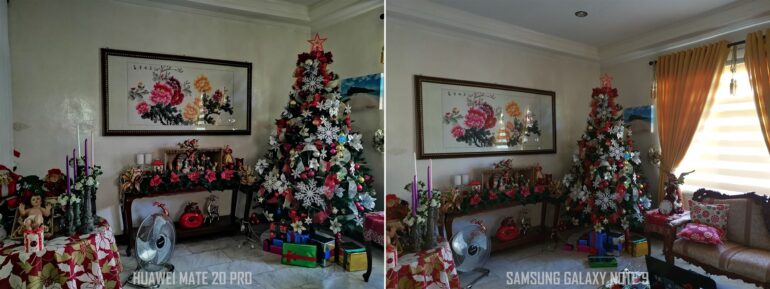
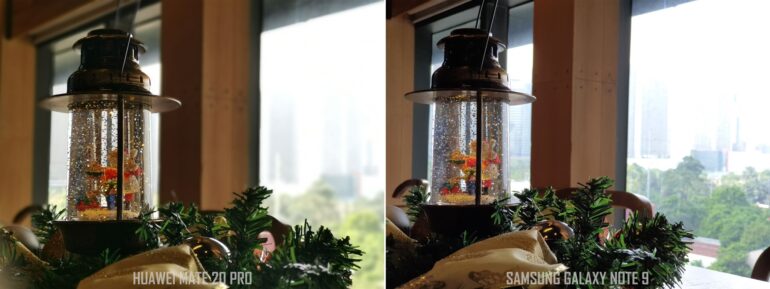 Mate 20 Pro and Galaxy Note 9 produced similarly impressive photos. With Auto Mode and AI enabled, both devices tried to look for the optimized setting before you hit that shutter button. As you can see in the photos above, the produced photos appear different. Mate 20 Pro’s photo has more contrast and saturation but relatively noisie. Note 9’s photo appears to have more color definition and balanced contrast and saturation.
Mate 20 Pro and Galaxy Note 9 produced similarly impressive photos. With Auto Mode and AI enabled, both devices tried to look for the optimized setting before you hit that shutter button. As you can see in the photos above, the produced photos appear different. Mate 20 Pro’s photo has more contrast and saturation but relatively noisie. Note 9’s photo appears to have more color definition and balanced contrast and saturation.
WIDE ANGLE
Pulling off a magnificent wide angle shots relies on the lens camera and camera smartphones possess. In the case of Mate 20 Pro, its ultra-wide lens is 16mm; Galaxy Note 9’s widest lens is 26mm. The former has a big advantage in terms of focal length; and the latter’s advantage is the variable aperture innate to its wide lens. Obviously, Mate 20 Pro slams the Galaxy Note 9 in this category.
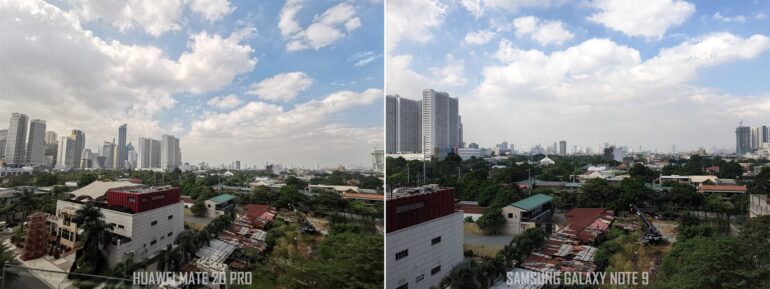
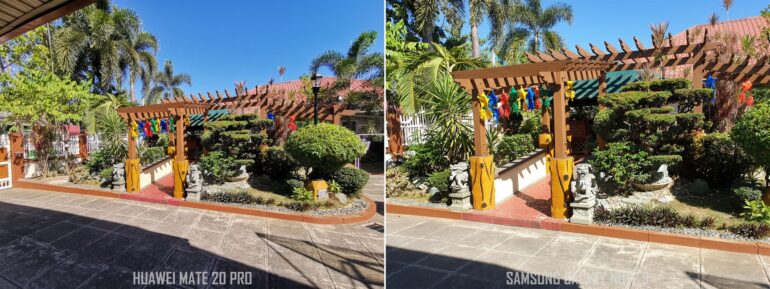
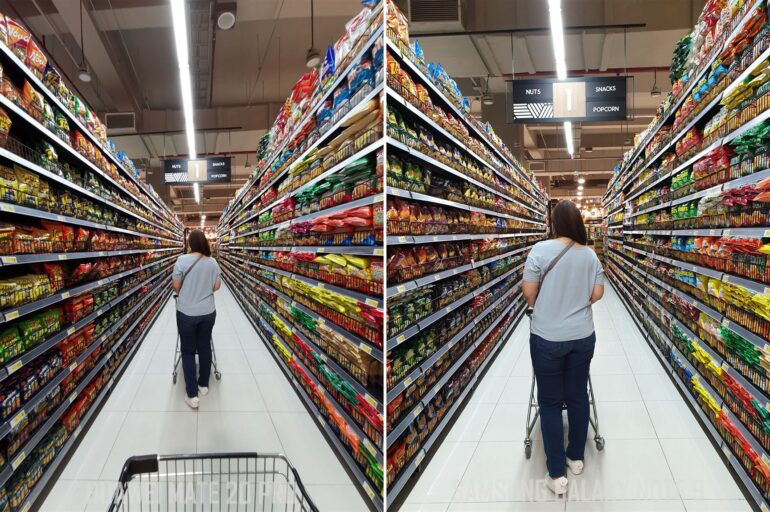
MACRO PHOTOGRAPHY
If there’s one mode that getting much attention this year, then it’s macro photography. People take photos of everything from flowers to ornaments. It’s amazing to know that new flagship camera smartphones nowadays lets users get close to their subject and do macro photography. We recently got engaged to this mode using Mate 20 Pro and the results were impressive. You can check them on this link.
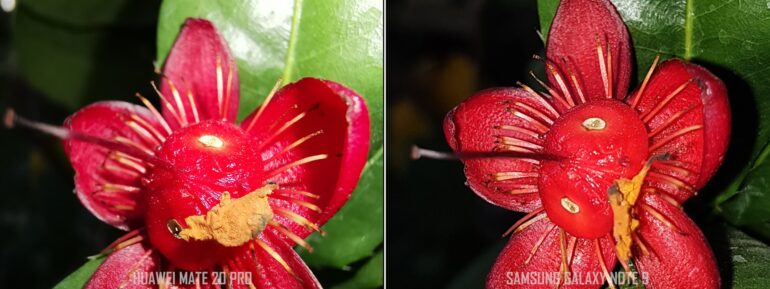
 It is possible to do macro photography on Mate 20 Pro and Galaxy Note 9. There is no dedicated toggle to enabled this as it heavily relies on AI. What it basically does is the AI (on either phones) automatically looks for the right settings to enable macro mode.
It is possible to do macro photography on Mate 20 Pro and Galaxy Note 9. There is no dedicated toggle to enabled this as it heavily relies on AI. What it basically does is the AI (on either phones) automatically looks for the right settings to enable macro mode.
Mate 20 Pro has a big advantage as it has plenty of lens with various focal lengths to use. In its case, it uses the wider lens, sets the optimized maximum aperture, brings down the ISO speed and tweaks exposure time to the right setting. Surprisingly, Mate 20 Pro does not automatically enable flash when Macro mode is enabled, which simulates macro light ring.
Note 9 hardly keeps up especially when taking less trickier subjects. It’s difficult to take macro shots using its available lens, and sometimes its AI wouldn’t trigger macro mode at all. Sometimes the only way to achieve it is to nail the focus and zoom it the subject to “simulate” macro photography.
FOOD PHOTOGRAPHY
In 2017, there was a study that 69% of millennials take photos of food before eating? Guess what, smartphone makes followed this trend and unapologetically enabled everyone with a mode that helps bring out the best possible setting to take a photo of the food you’re about to partake.
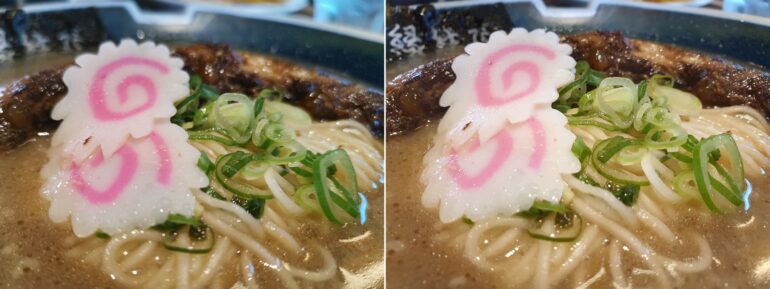 Both smartphones we’re talking about have this feature, and we’re excite to tell you that both performed right at similar circumstance. If you want a softer look of unfocused areas, go with the Mate 20 Pro, if you want sharper shots, Galaxy Note 9 is the phone you’re looking for.
Both smartphones we’re talking about have this feature, and we’re excite to tell you that both performed right at similar circumstance. If you want a softer look of unfocused areas, go with the Mate 20 Pro, if you want sharper shots, Galaxy Note 9 is the phone you’re looking for.
SELFIE
Speaking of taking millennials, did you know that they are expected to take a total of 25,000 selfies in their lifetime? It’s already epidemic, and the usual tools to doing pull off epic selfies are smartphones.
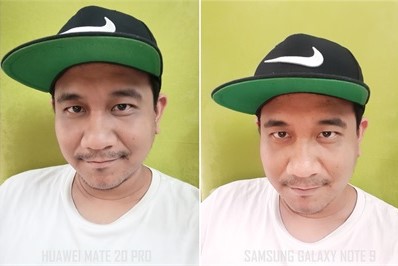
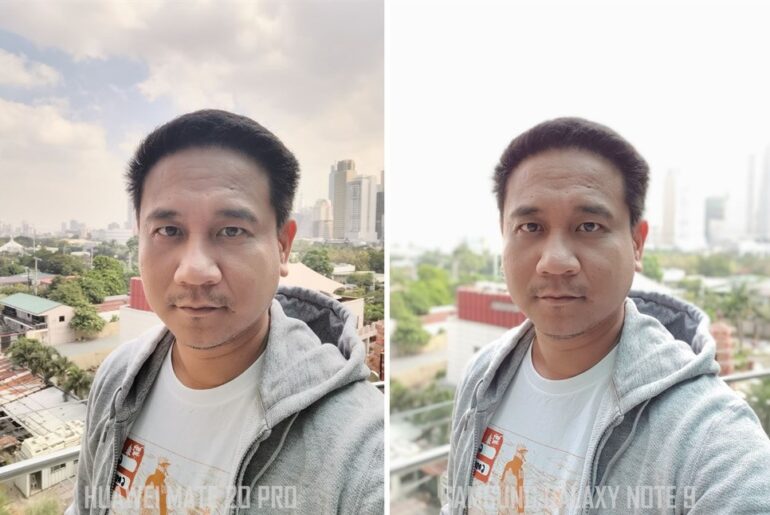 Huawei Mate 20 Pro and Galaxy Note 9 are, by far, among the best smartphones that can allow you take better-looking selfies. Pardon us, but below are some sample selfie shots we took using both devices.
Huawei Mate 20 Pro and Galaxy Note 9 are, by far, among the best smartphones that can allow you take better-looking selfies. Pardon us, but below are some sample selfie shots we took using both devices.
There you have it. If you’re in market for a new flagship smartphone, by this time you should already have an idea which smartphone to get. The Huawei Mate 20 Pro is now available at flagship stores nationwide for PhP49,990. Galaxy Note 9, on the other hand, is also available for PhP51,990.
Giancarlo Viterbo is a Filipino Technology Journalist, blogger and Editor of gadgetpilipinas.net, He is also a Geek, Dad and a Husband. He knows a lot about washing the dishes, doing some errands and following instructions from his boss on his day job. Follow him on twitter: @gianviterbo and @gadgetpilipinas.





